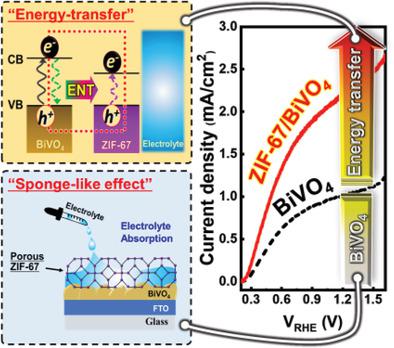当前位置:
X-MOL 学术
›
Small Methods
›
论文详情
Our official English website, www.x-mol.net, welcomes your
feedback! (Note: you will need to create a separate account there.)
Energy Transfer‐Induced Photoelectrochemical Improvement from Porous Zeolitic Imidazolate Framework‐Decorated BiVO4 Photoelectrodes
Small Methods ( IF 10.7 ) Pub Date : 2020-11-17 , DOI: 10.1002/smtd.202000753 Cheol Hyoun Ahn 1, 2 , Nishad G Deshpande 1, 2 , Ho Seong Lee 3 , Hyung Koun Cho 1, 2
Small Methods ( IF 10.7 ) Pub Date : 2020-11-17 , DOI: 10.1002/smtd.202000753 Cheol Hyoun Ahn 1, 2 , Nishad G Deshpande 1, 2 , Ho Seong Lee 3 , Hyung Koun Cho 1, 2
Affiliation

|
BiVO4, which is a representative photoanode material for photoelectrochemical water splitting, intrinsically restricts high conversion efficiency, owing to faster recombination, low electron mobility, and short electron diffusion length. While the photocurrent density of typical BiVO4 corresponds to only 21.3% of the maximum photocurrent density (4.68 mA cm−2), decoration of the BiVO4 photoanode with zeolitic imidazolate framework‐67 (ZIF‐67) exhibits a synergetic effect to raise the overall photocatalytic ability at the BiVO4 surface region to a higher level via the energy‐transfer process from BiVO4 to ZIF‐67. The hybrid ZIF‐67/BiVO4 photoanode follows two convenient photoelectrochemical pathways: 1) energy‐transfer‐induced water oxidation reaction in ZIF‐67 and 2) water oxidation reaction by direct contact between the BiVO4 surface and electrolytes. Compared to the moderate photocurrent density (≈1 mA cm−2) of single‐layer BiVO4, the proposed ZIF‐67/BiVO4 photoanodes show a remarkably high photocurrent (2.25 mA cm−2) with high stability, despite the lack of hole scavengers in the electrolyte. Furthermore, the absorbed photon‐to‐current efficiency of the ZIF‐67/BiVO4 photoanode is ≈2.5 times greater than that of BiVO4. This work proposes a promising solution for efficient water oxidation that overcomes the intrinsic material limitations of BiVO4 photoelectrodes by using energy transfer‐induced photon recycling and the decoration of porous ZIFs.
中文翻译:

多孔沸石咪唑酯骨架修饰的 BiVO4 光电极的能量转移诱导光电化学改进
BiVO 4是一种具有代表性的光电化学水分解光阳极材料,由于复合速度快、电子迁移率低和电子扩散长度短,从本质上限制了高转换效率。虽然典型 BiVO 4的光电流密度仅对应于最大光电流密度 (4.68 mA cm -2 ) 的21.3%,但用沸石咪唑酯骨架-67 (ZIF-67)装饰 BiVO 4 光阳极表现出协同效应以提高在BiVO总体光催化能力4表面区域通过从BiVO能量传递过程更高级别4到ZIF-67。杂化 ZIF-67/BiVO 4光阳极遵循两种方便的光电化学途径:1)ZIF-67 中能量转移诱导的水氧化反应和 2)BiVO 4表面与电解质直接接触的水氧化反应。相较于中等光电流密度(≈ 1毫安厘米-2单层的)BiVO 4,所提出的ZIF-67 / BiVO 4个光阳极显示出显着高的光电流(2.25毫安厘米-2)具有高稳定性,尽管缺乏电解液中的空穴清除剂。此外,所吸收的光子-电流的效率ZIF-67 / BiVO 4光电阳极是≈比BiVO的2.5倍的4. 这项工作提出了一种有效的水氧化解决方案,通过使用能量转移诱导的光子循环和多孔 ZIF 的装饰,克服了 BiVO 4光电极的固有材料限制。
更新日期:2020-11-17
中文翻译:

多孔沸石咪唑酯骨架修饰的 BiVO4 光电极的能量转移诱导光电化学改进
BiVO 4是一种具有代表性的光电化学水分解光阳极材料,由于复合速度快、电子迁移率低和电子扩散长度短,从本质上限制了高转换效率。虽然典型 BiVO 4的光电流密度仅对应于最大光电流密度 (4.68 mA cm -2 ) 的21.3%,但用沸石咪唑酯骨架-67 (ZIF-67)装饰 BiVO 4 光阳极表现出协同效应以提高在BiVO总体光催化能力4表面区域通过从BiVO能量传递过程更高级别4到ZIF-67。杂化 ZIF-67/BiVO 4光阳极遵循两种方便的光电化学途径:1)ZIF-67 中能量转移诱导的水氧化反应和 2)BiVO 4表面与电解质直接接触的水氧化反应。相较于中等光电流密度(≈ 1毫安厘米-2单层的)BiVO 4,所提出的ZIF-67 / BiVO 4个光阳极显示出显着高的光电流(2.25毫安厘米-2)具有高稳定性,尽管缺乏电解液中的空穴清除剂。此外,所吸收的光子-电流的效率ZIF-67 / BiVO 4光电阳极是≈比BiVO的2.5倍的4. 这项工作提出了一种有效的水氧化解决方案,通过使用能量转移诱导的光子循环和多孔 ZIF 的装饰,克服了 BiVO 4光电极的固有材料限制。











































 京公网安备 11010802027423号
京公网安备 11010802027423号